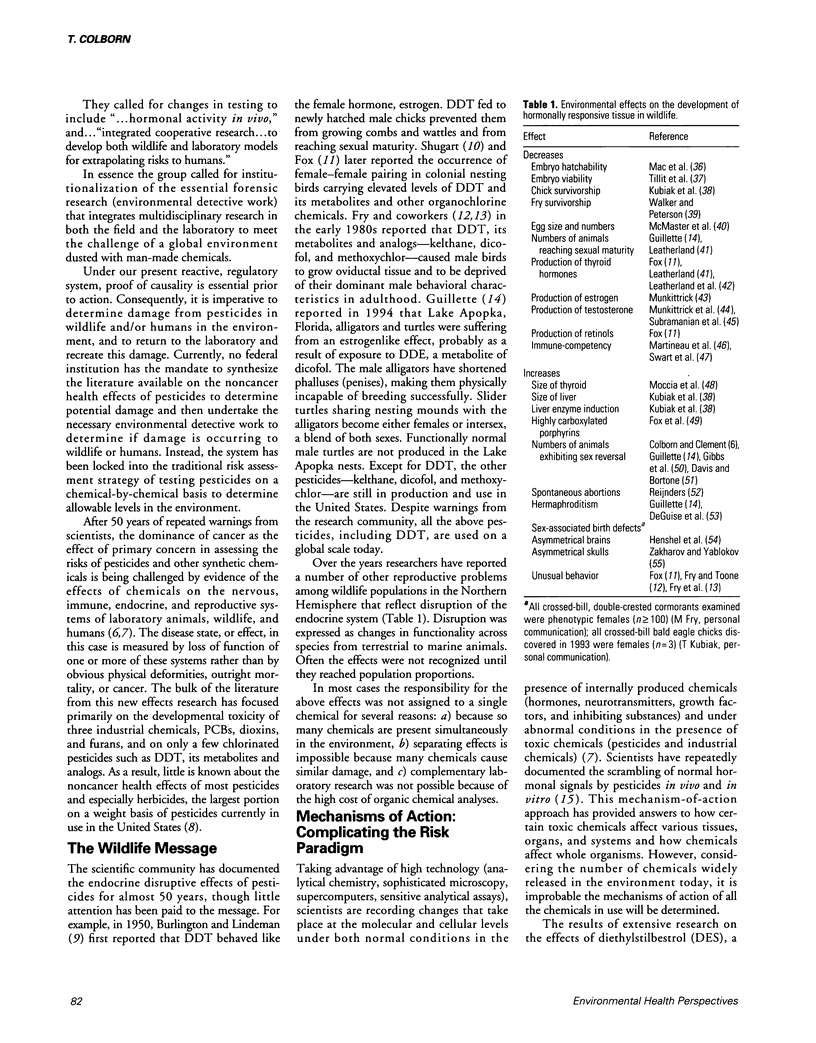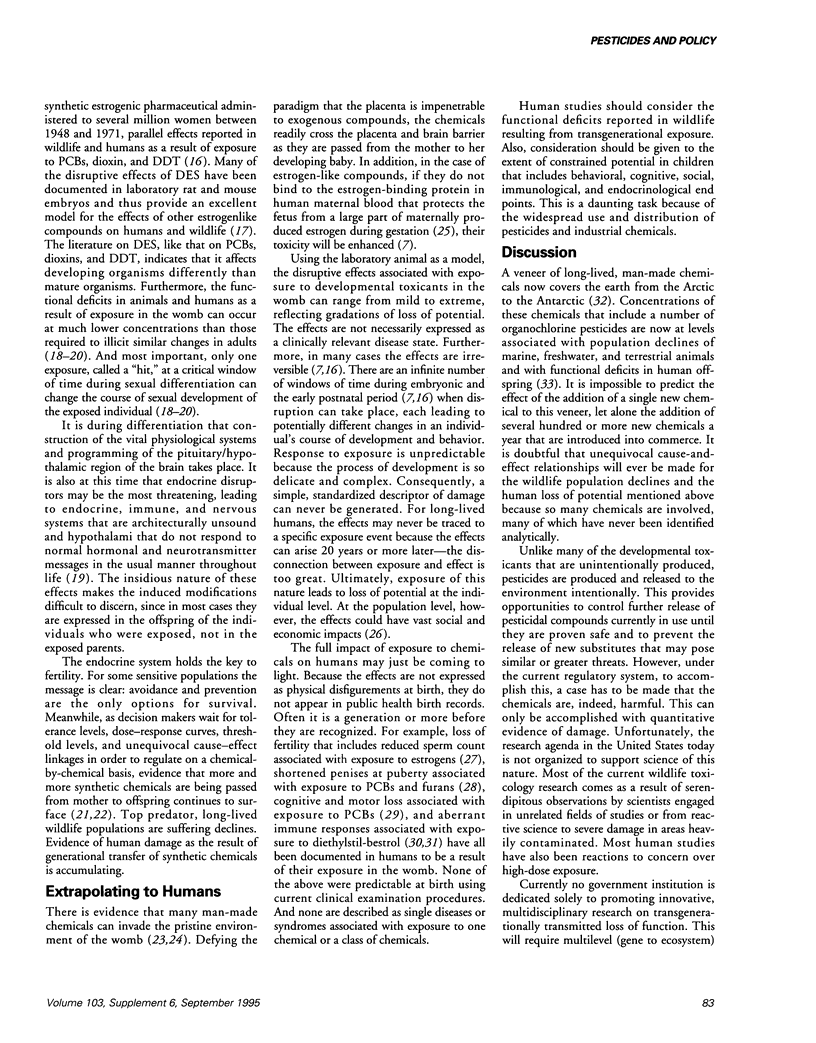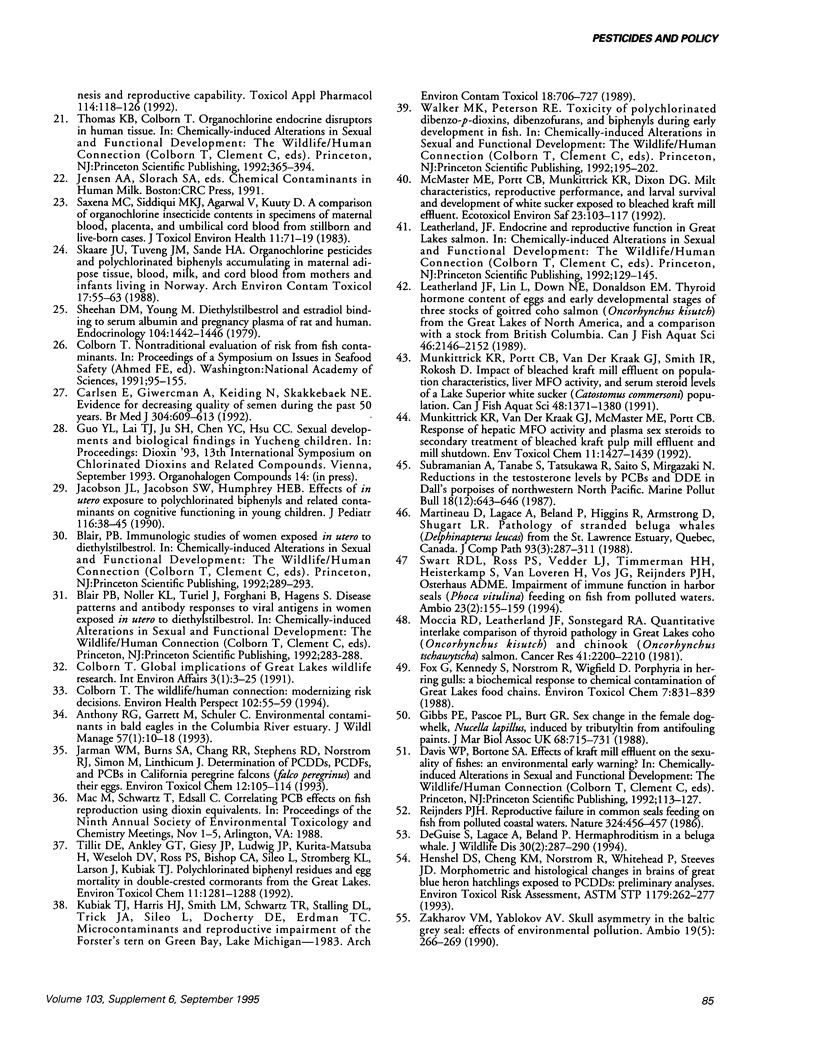Abstract
Toxicological research became institutionalized in the United States in response to society's concern about cancer and acute mortality. Driven by risk assessment, research focused on the need for data development and the standardization of testing for regulatory and management purposes in a reactive mode. Although the research community has provided evidence for over 40 years that a number of pesticides and industrial chemicals have disruptive effects on the endocrine system, little attention was given to the evidence when determining the health hazards of synthetic chemicals because of the fixation on cancer. However, recent findings concerning the effects of a number of widespread chemicals on the reproductive success and fertility of wildlife and humans has led to the call for a proactive approach using investigative research (forensic science). Suggestions are presented to modernize the research agenda of public health institutions to meet society's needs to address the problems of exposure to endocrine, nervous, and immune system disruptors.
Full text
PDF




Selected References
These references are in PubMed. This may not be the complete list of references from this article.
- BURLINGTON H., LINDEMAN V. F. Effect of DDT on testes and secondary sex characters of white leghorn cockerels. Proc Soc Exp Biol Med. 1950 May;74(1):48–51. doi: 10.3181/00379727-74-17805. [DOI] [PubMed] [Google Scholar]
- Carlsen E., Giwercman A., Keiding N., Skakkebaek N. E. Evidence for decreasing quality of semen during past 50 years. BMJ. 1992 Sep 12;305(6854):609–613. doi: 10.1136/bmj.305.6854.609. [DOI] [PMC free article] [PubMed] [Google Scholar]
- Colborn T. The wildlife/human connection: modernizing risk decisions. Environ Health Perspect. 1994 Dec;102 (Suppl 12):55–59. doi: 10.1289/ehp.94102s1255a. [DOI] [PMC free article] [PubMed] [Google Scholar]
- Colborn T., vom Saal F. S., Soto A. M. Developmental effects of endocrine-disrupting chemicals in wildlife and humans. Environ Health Perspect. 1993 Oct;101(5):378–384. doi: 10.1289/ehp.93101378. [DOI] [PMC free article] [PubMed] [Google Scholar]
- Fry D. M., Toone C. K. DDT-induced feminization of gull embryos. Science. 1981 Aug 21;213(4510):922–924. doi: 10.1126/science.7256288. [DOI] [PubMed] [Google Scholar]
- Jacobson J. L., Jacobson S. W., Humphrey H. E. Effects of in utero exposure to polychlorinated biphenyls and related contaminants on cognitive functioning in young children. J Pediatr. 1990 Jan;116(1):38–45. doi: 10.1016/s0022-3476(05)81642-7. [DOI] [PubMed] [Google Scholar]
- Kubiak T. J., Harris H. J., Smith L. M., Schwartz T. R., Stalling D. L., Trick J. A., Sileo L., Docherty D. E., Erdman T. C. Microcontaminants and reproductive impairment of the Forster's tern on Green Bay, Lake Michigan--1983. Arch Environ Contam Toxicol. 1989 Sep;18(5):706–727. doi: 10.1007/BF01225009. [DOI] [PubMed] [Google Scholar]
- Mably T. A., Bjerke D. L., Moore R. W., Gendron-Fitzpatrick A., Peterson R. E. In utero and lactational exposure of male rats to 2,3,7,8-tetrachlorodibenzo-p-dioxin. 3. Effects on spermatogenesis and reproductive capability. Toxicol Appl Pharmacol. 1992 May;114(1):118–126. doi: 10.1016/0041-008x(92)90103-y. [DOI] [PubMed] [Google Scholar]
- Mably T. A., Moore R. W., Goy R. W., Peterson R. E. In utero and lactational exposure of male rats to 2,3,7,8-tetrachlorodibenzo-p-dioxin. 2. Effects on sexual behavior and the regulation of luteinizing hormone secretion in adulthood. Toxicol Appl Pharmacol. 1992 May;114(1):108–117. doi: 10.1016/0041-008x(92)90102-x. [DOI] [PubMed] [Google Scholar]
- Mably T. A., Moore R. W., Peterson R. E. In utero and lactational exposure of male rats to 2,3,7,8-tetrachlorodibenzo-p-dioxin. 1. Effects on androgenic status. Toxicol Appl Pharmacol. 1992 May;114(1):97–107. doi: 10.1016/0041-008x(92)90101-w. [DOI] [PubMed] [Google Scholar]
- Martineau D., Lagacé A., Béland P., Higgins R., Armstrong D., Shugart L. R. Pathology of stranded beluga whales (Delphinapterus leucas) from the St. Lawrence Estuary, Québec, Canada. J Comp Pathol. 1988 Apr;98(3):287–311. doi: 10.1016/0021-9975(88)90038-2. [DOI] [PubMed] [Google Scholar]
- McMaster M. E., Portt C. B., Munkittrick K. R., Dixon D. G. Milt characteristics, reproductive performance, and larval survival and development of white sucker exposed to bleached kraft mill effluent. Ecotoxicol Environ Saf. 1992 Feb;23(1):103–117. doi: 10.1016/0147-6513(92)90025-x. [DOI] [PubMed] [Google Scholar]
- Moccia R. D., Leatherland J. F., Sonstegard R. A. Quantitative interlake comparison of thyroid pathology in Great Lakes coho (Oncorhynchus kisutch) and chinook (Oncorhynchus tschawytscha) salmon. Cancer Res. 1981 Jun;41(6):2200–2210. [PubMed] [Google Scholar]
- Reijnders P. J. Reproductive failure in common seals feeding on fish from polluted coastal waters. Nature. 1986 Dec 4;324(6096):456–457. doi: 10.1038/324456a0. [DOI] [PubMed] [Google Scholar]
- Saxena M. C., Siddiqui M. K., Agarwal V., Kuuty D. A comparison of organochlorine insecticide contents in specimens of maternal blood, placenta, and umbilical-cord blood from stillborn and live-born cases. J Toxicol Environ Health. 1983 Jan;11(1):71–79. doi: 10.1080/15287398309530321. [DOI] [PubMed] [Google Scholar]
- Sheehan D. M., Young M. Diethylstilbestrol and estradiol binding to serum albumin and pregnancy plasma of rat and human. Endocrinology. 1979 May;104(5):1442–1446. doi: 10.1210/endo-104-5-1442. [DOI] [PubMed] [Google Scholar]
- Skaare J. U., Tuveng J. M., Sande H. A. Organochlorine pesticides and polychlorinated biphenyls in maternal adipose tissue, blood, milk, and cord blood from mothers and their infants living in Norway. Arch Environ Contam Toxicol. 1988 Jan;17(1):55–63. doi: 10.1007/BF01055154. [DOI] [PubMed] [Google Scholar]


